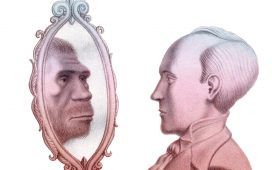The first time I stepped inside Akbar, Silverlake’s gay watering hole, I felt horribly out of place. My lavender bell bottoms, pink ribbed halter, and iridescent manicure looked gaudy in a room full of baggy, Carhartt denim, white tanks, and trucker hats. I meandered through the dense, sweaty crowd to order myself a drink. The bartender — a Stanley Kowalski lookalike — leaned his upper body over the bar, and I raised my voice just enough to be heard over the seventies jukebox anthems, “Tequila soda, please!”
I caught a glimpse of myself in the mirror behind the bar; my pastel reflection looked amateurish in comparison to a mass of men uniformly dressed like they knew how to change a tire. Soon I sought refuge in a dimly lit corner of the room, clutching my drink, trembling in my hip huggers, and wondering: When did gay men start dressing like the jocks I avoided in high school?
From leather-clad Tom of Finland-esque daddies to the “Castro clones” whose outfits emulated an idealized version of working-class men, gays have been playing with hypermasculine attire for generations. Though I felt certain the boys surrounding me at Akbar were more focused on dressing to get laid than making a historical reference, the rugged persona seemed to be making a resurgence. And if I wanted to fit in at Akbar, it seemed like I’d have to trade in my lavender bell bottoms for a pair of camo cargos.
I rejected this realization; I had only recently broken free of the lifelong expectation to dress “like a man.” For most of my life, I had felt shame for wanting what the girls wanted: Barbies, the color pink, to kiss a boy. As a child, I wrapped blankets around my waist and paraded around the house, imagining I was wearing a dress; my beauty felt as boundless as my imagination. But, like many of us, I started receiving signals that my feminine proclivities were unacceptable — from my family, from kids at school, from the McDonald’s worker who looked confused to be handing me the girl’s Happy Meal toy. As my shame compounded, I distanced myself from anything overtly “gay.” Even after I came out, it took me until my mid-twenties to feel comfortable enough to invite to the surface what I had been taught to bury. My painted nails and colorful outfits reflected my hard-won battle to embrace my femininity. They were my sign of self-acceptance; I wore them like a badge of honor.
But that night at Akbar, my badge felt more like a scarlet letter. Ironically, these days when I see a boy with nails painted like mine, I have to think twice about whether or not he’s gay. Seemingly, the rise of waifish icons like Harry Styles and Timothée Chalamet has inspired a wave of straight men to adopt traditionally feminine markers. Of course, everyone should have the right to express themselves and experiment with clothing. Yet this shift in style is unsettling to me because for many of these straight men, it’s just a trend. Their femininity ceases to be when they take off their pearls. They don’t have to endure the same obstacles gay men and other queers face when we choose to dress in the same fashion, especially after our accessories come off.







